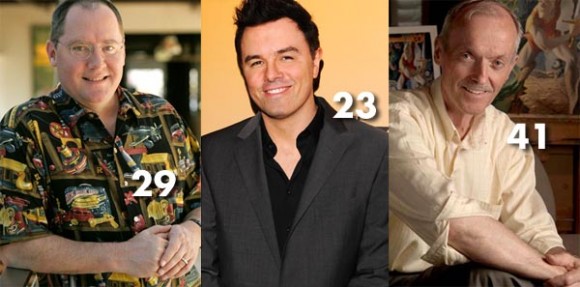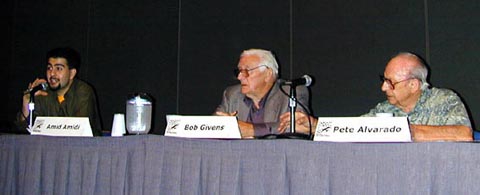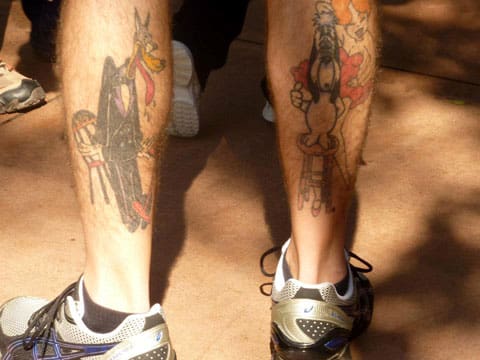"They don't make animation like this anymore," says Warner Bros. exec Mary Ellen Thomas.
The post Warner Bros. Is Releasing A ‘Timeless Classic’ Onto DVD In June appeared first on Cartoon Brew.
Add a Comment
"They don't make animation like this anymore," says Warner Bros. exec Mary Ellen Thomas.
The post Warner Bros. Is Releasing A ‘Timeless Classic’ Onto DVD In June appeared first on Cartoon Brew.
Add a CommentThe directors of "The Lego Movie" were honored for their achievements in the field of animation.
Add a CommentIn this 1980 tribute to legendary animation director Tex Avery, fellow legendary director Chuck Jones shared six lessons that he learned about comedy from working with Avery in the 1930s. The advice remains essential to animation director working today.
Add a CommentFor the past few days on Cartoon Brew's Instagram account, we've been running a series called 25 Cartoonists You Should Know. The entire series is below, and yes, the list could easily be twice as long and still incomplete.
Add a CommentLast weekend the town of Taylor, Texas held their first-ever Tex Avery Day in honor of their hometown animation hero. Here is a look at what happened.
Add a Comment
Gigglebug, a newly released iPad app from Finland, uses infectious laughter to encourage social play among children. Through touching and swiping the screen, players can tickle various 2D animated characters to make them smile and laugh. This sort of interactive, responsive play is irresistible to kids, and elicits a reaction that may or may not be desirable to parents:
Infectious laughter has proven to be a guaranteed form of entertainment—how else could videos of laughing babies have 60 million views on YouTube? Several cartoons, toys and other products have found success in using laughter, such as Sesame Street shorts and Tickle Me Elmo.
Then there’s Sh-h-h-h-h-h, a clasic Tex Avery cartoon about a man trying to escape the constant laughter and noise of his surroundings. The soundtrack of the cartoon comes from the early-1920s Okeh Laughing Record, a bizarre recording that features a man and woman laughing uncontrollably.
Gigglebug also features lush watercolor backgrounds and laugh scenes that are fully animated with quality not often seen in 2D animated apps. Not surprisingly, the app was developed in part by Helsinki-based Anima Boutique which has extensive experience producing animation for entertainment purposes. They are simultaneously developing Gigglebug as a children’s TV series. The success of another Finnish creation, Angry Birds, appears to have normalized the idea that a successful app can lead to cross-media adaptations on more traditional platforms like TV and film.
Add a Comment

Cartoon women are inherently difficult subjects for the animator for the reason that animation demands caricature and comedy, which are concepts inconsistent with femininity, grace and sensuality. The result is that when animators create female leads, they tend to de-emphasize cartoon qualities and accentuate realistic mannerisms and behaviors.
There was a brief moment in animation history when funny and sexy female characters were encouraged though, and that era coincided roughly with World War II. Some historians, like John Costello, have argued that the war represented the true beginnings of the sexual revolution in the United States. During the early-1940s, sexual imagery gained new visibility and cultural acceptance. Young soldiers lusted after Betty Grable and Rita Hayworth pin-ups, while reading Milton Caniff’s comic Male Call and decorating their bombers with provocative nose art. Within this liberal environment, Hollywood directors and animators took advantage of the opportunity to explore creative new ways of portraying the female character in animation.

A handful of animators, notably Pat Matthews, Preston Blair, Rod Scribner, Fred Moore, and Milt Kahl, became known for their ability to handle women characters that were true cartoon creations. Still, there were limited opportunities to animate such characters, and it wasn’t uncommon for animators to use male characters in drag as a substitute for the female, such as Daffy Duck’s striptease in The Wise Quacking Duck (1943), animated by Art Babbitt.
The sexy cartoon female occasionally appeared in animation after the war, but by and large, the industry began to favor a blander and less cartoon-influenced style. By the early-1960s, the average cartoon female in Hollywood animation had become so unappealing that Rocky and Bullwinkle co-creator Bill Scott quipped, “The way women are drawn in our business today, one would assume all the artists are fags.”
The following selection of animated films illustrate some of the various approaches to the animated female character during the World War II period:
“Eatin’ on the Cuff” or The Moth who Came to Dinner (Warner Bros, Bob Clampett, 1942)
Coal Black and de Sebben Dwarfs (Warner Bros, Bob Clampett 1943)
Red Hot Riding Hood (MGM, Tex Avery, 1943)
Abou Ben Boogie (Walter Lantz Prod, Shamus Culhane, 1944)
Plane Daffy (Warner Bros, Frank Tashlin, 1944)
Duck Pimples (Disney, Jack Kinney, 1945)

“Animation is a young man’s game,” Chuck Jones once said. There’s no question that animation is a labor-intensive art that requires mass quantities of energy and time. While it’s true that the majority of animation directors have directed a film by the age of 30, there are also a number of well known directors who started their careers later.
Directors like Pete Docter, John Kricfalusi and Bill Plympton didn’t begin directing films until they were in their 30s. Don Bluth, Winsor McCay and Frederic Back were late bloomers who embarked on directorial careers while in their 40s. Pioneering animator Emile Cohl didn’t make his first animated film, Fantasmagorie (1908), until he was 51 years old. Of course, that wasn’t just Cohl’s first film, but it is also considered by most historians to be the first true animated cartoon that anyone ever made.
Here is a cross-selection of 30 animation directors, past and present, and the age they were when their first professional film was released to the public.
Seventy-two years ago today — on July 27th, 1940 — Bugs Bunny appeared in Tex Avery’s A Wild Hare. The Warner Bros. short is widely considered to be the first definitive Bugs Bunny cartoon, in which the character’s appearance, personality and voice gelled as a whole. It’s also the first time Bugs, voiced by the inimitable Mel Blanc, uttered his famous catchphrase, “What’s up, doc?”
All the major players involved with the production of A Wild Hare are dead except for one individual: 94-year-old Bob Givens. He was the character designer who redesigned the studio’s clumsy-looking rabbit character into the familiar design below. You’ll notice that Givens calls the character “Tex’s Rabbit” because they hadn’t officially christened him Bugs Bunny yet.

Bob can also claim responsibility for redesigning Elmer Fudd into the recognizable character that we know today. He speaks about working on A Wild Hare in this interview conducted by animation historian Steve Worth and animators Will Finn and Mike Fontanelli:
Bob Givens means a lot to me personally because he was the first animation artist that I ever interviewed. Who knows where I’d be today if Bob hadn’t been patient and encouraging of my interest in documenting animation history. I wish I could remember how I got in touch with him—it may have been simply by looking him up in the phone book—but when I first went to Bob’s modest bungalow home in North Hollywood, I was unaware of just how much of a key figure he’d been throughout the history of Golden Age Hollywood animation. I learned quickly though.
In 2001, a few years after our first interview, I had the honor of interviewing Bob a second time. This time it was onstage at the San Diego Comic-Con International where he was joined by fellow WB veteran Pete Alvarado. It’s doubtful that the event was recorded onto video, but this photographic memory remains:

Cartoon Brew |
Permalink |
No comment |
Post tags: Bob Givens, Mel Blanc, Tex Avery, Warner Bros.
Tex Avery tats spotted on line at Disney World. You know what? “I’m happy!”

(Thanks, Uncle Wayne)
Cartoon Brew: Leading the Animation Conversation |
Permalink |
One comment |
Post tags: tattos, Tex Avery